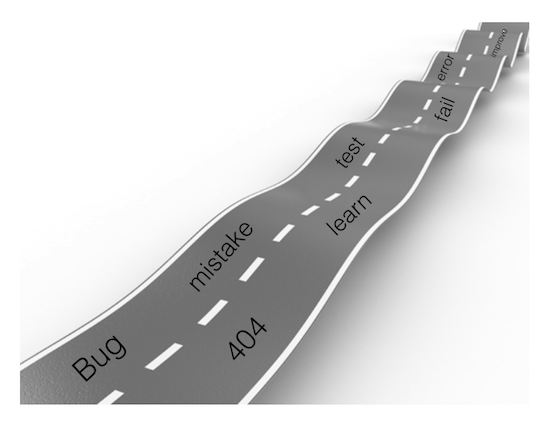As companies grapple with the process of digital transformation, there is a rampant search for best practices, secret recipes and potential shortcuts. The truth is that each company will need to find its own path, based on its business, strategy, client base, company culture and leadership. {Tweet this!} To the extent so many companies are now on the “digital mission,” the difference will come down to execution. And, in this, a sense of accountability becomes sine qua non.
Looking for signs

Watching for signs
There will be winners and losers and a whole lot of muddlers-along. The signs that I look for in gauging the potential for successful adoption of the digital mindset include:
- The vested interest and active participation of the entire C-suite
- A shared sense of purpose throughout the organization
- A genuine recognition (if not fear) of the risks of not mobilizing
- The vibrancy and engagement of all ranks on the intranet and/or internal social network
- A culture of responsibility (for example, objectives are systematically SMART)
Planning for errors
When one talks of creating digital systems and solutions, the IT teams inevitably consider redundancies and contingencies. And this is entirely appropriate and necessary to the extent that bugs and breakdowns will occur. One needs to have back-ups and anticipate technical issues. That should go without saying. Except, it is my observation in far too many instances, that when it comes to implementing digital in retail, for example, technological snafus are regularly present and not well-managed–I would argue because they have not been anticipated.
Accepting failures and mistakes in management
If technology inevitably involves debugging and fixing, it stands to reason that trying out new technologies will require experimentation, testing, learning and improving. But, many executives have been hardwired to strive for perfection. Management’s non-conciliatory nature about mistakes not only curtails ambition, it dramatically constrains the opportunities and drags out the process. {Please tweet this!} This management intransigence is deeply counter-productive in the implementation of new digital tools and platforms.  Everyone has to learn — including management — their way about. And, if there is one thing that is becoming crystal clear, the successful implementation of a digital strategy requires equal portions of human involvement, process and the right technology. {Tweet this!} Unfortunately, there is no easy way to create “back-ups” when it comes to testing and learning. In fact, in terms of management practice and managerial attitude, if one tries to set up redundancies in terms of people’s responsibilities, it is a sure-fire way to throttle progress. For example: when a boss who gives the responsibility for a certain project to multiple people. Or even worse: when the boss does not tell each individual that others have also been tasked with the project ‘leadership.’ Not only does this type of redundancy create duplication and confusion, it naturally disengages employees. I was struck by some of the recent failures, notably, with the U.S. President’s security breaches, where everyone thought that the other was working. The issue with having redundancies is that no one owns the buck. Thus, the responsibility and sense of accountability is dispersed, if not dissipated.
Everyone has to learn — including management — their way about. And, if there is one thing that is becoming crystal clear, the successful implementation of a digital strategy requires equal portions of human involvement, process and the right technology. {Tweet this!} Unfortunately, there is no easy way to create “back-ups” when it comes to testing and learning. In fact, in terms of management practice and managerial attitude, if one tries to set up redundancies in terms of people’s responsibilities, it is a sure-fire way to throttle progress. For example: when a boss who gives the responsibility for a certain project to multiple people. Or even worse: when the boss does not tell each individual that others have also been tasked with the project ‘leadership.’ Not only does this type of redundancy create duplication and confusion, it naturally disengages employees. I was struck by some of the recent failures, notably, with the U.S. President’s security breaches, where everyone thought that the other was working. The issue with having redundancies is that no one owns the buck. Thus, the responsibility and sense of accountability is dispersed, if not dissipated.
When a person can get away with saying, “I thought it would be taken care of by someone else,” you know the culture lacks accountability. Digital transformation is not some ONE’s responsibility. It is everyone’s. {Tweet this!}
Becoming more digital is not something one can delegate. {Do tweet this!}
Even the CEO must take it upon him or herself to become more digitally fluent.
Organizations, where objectives are not SMART and roles and responsibilities are not clear, are typically subject to real operational challenges. According to the business, it can make sense not to have too many “corporate” titles in order to privilege a more agile, project-based setup. That said, I would tend to believe that even the vagaries in roles and responsibilities can be surmounted to a degree when the team keenly knows (and believes) “why” they are in business.












As a technologist I would, of course, be saying that the biggest cause of failure is with a lack of clear strategy. “Let’s go digital” just isn’t enough. The whole business needs a strategy – they need to fully understand what the strategy is and how it impacts them. Leaving it to the techies doesn’t work…
@Roland, it’s very rarely the technology’s fault! This awakes the question of when machines will be installed to replace humans when and where they (we) are most prone to make mistakes (filling prescriptions, cashiers…).